Chinese fringe flowers: Grow & Care for Loropetalum chinense
Written by Iris
Aug 19 2021
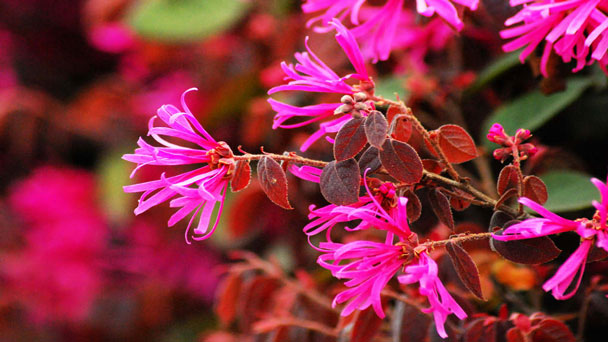
Chinese fringe flowers (Loropetalum chinense) have long been known to professional gardeners, but it is only in recent decades that Chinese fringe flowers have gained public interest. Chinese fringe flowers (Loropetalum chinense) is an attractive evergreen with rounded leaves growing horizontally from the stem. Most garden Chinese fringe flowers (Loropetalum chinense) are small, between 3 and 10 feet tall, depending on the species and the age of the plant. The distinctive flowers, like witch hazel, grow in clusters with narrow, ribbon-shaped petals. They are white to yellow.
There is a tendency to just use plain evergreens around the house, often neatly trimmed. Consider adding plants like the Loropetalum to those areas – their foliage shows well against the rich greens, and their more casual growth contrasts perfectly with those rounded forms. That touch of color really lifts your foundation planting to a new level you will love – for no extra work.
Fringe Flowers are also perfect for larger planter boxes and tubs. Because they are so colorful you don't even need to plant anything else, and they live for years, with regular watering and fertilizer. In colder parts of zone 7 they may not be so suitable, as winter lows could cause root damage, but in other zones they will be just fine.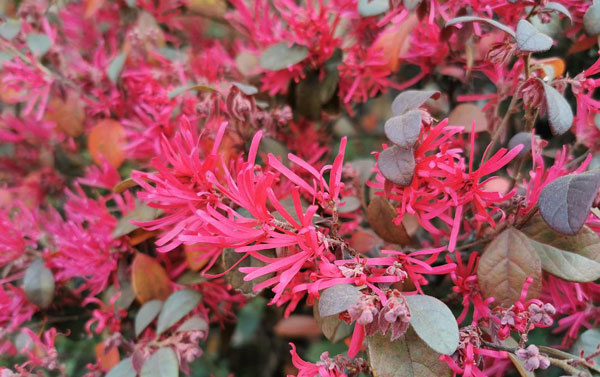
An ideal moment for planting seedlings is from October to the end of March, but it is essential to avoid frost periods. Wait for the soil to become drier, and dig a hole. It should be three times as wide as the root system of your Chinese fringe flower.
Put the 4 to 6 inches (10 – 15 cm) long seedling in the hole, and add the soil. After abundant watering, place a thick layer of organic mulch on the top.
Fill a container with a potting mixture made from equal parts of perlite and peat moss. The pot should have drainage holes at the bottom to prevent your cuttings from experiencing soggy conditions. Plant the cuttings in the substrate and cover the pot with a plastic wrap or bag, making sure the material does not touch the Chinese Fringe babies.
If you place the container in a warm location where they can receive plenty of indirect light and maintain the soil constantly damp, there is nothing else to do on your part. The cuttings should develop a strong root system in four to six weeks after planting. Once that period has ended, uncover the pot and care for the cuttings as for their mother plant. Let the little Chinese Fringe flowers in the current pot until the next planting season, then transplant them into the garden or their individual pots.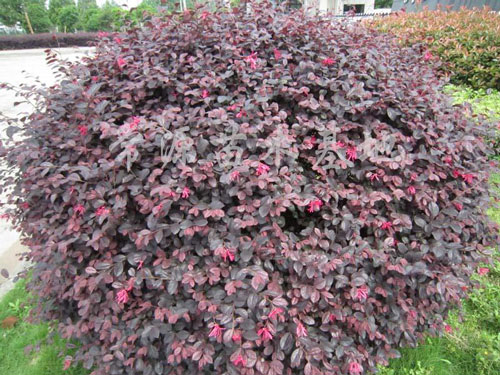
Even though experts recommend growing this shrub in the acidic soil, most of them will do well in the alkaline ground as well. However, some varieties won’t thrive if the pH is higher than 5.1 to 5.5. As a result, you can experience the occurrence of yellow and malformed foliage, short branches, and a lack of blooms.
To check for soil moisture use your finger or a hand trowel to dig a small hole and examine the soil. If the first 2-4” (5-10cm) of soil is dry, it is time to water.
Monitor new plants through the first two years to make sure they are getting the moisture they need. After that they should be sturdy enough to survive on their own.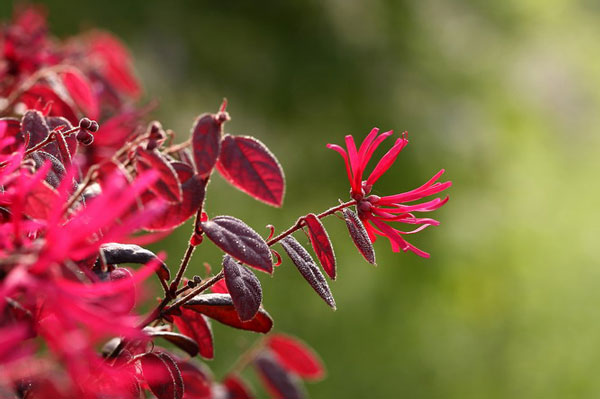
Fertilizers are available in many forms: granulated, slow-release, liquid feeds, organic or synthetic. Determine which application method is best for the situation and select a product designed for trees and shrubs, or go with a nutritionally balanced, general-purpose formula such as 10-10-10.
Always follow the fertilizer package directions for application rates and scheduling. Over-fertilizing plants or applying at the wrong time during the growing season can result in plant injury.
Dead branches should be removed close to the trunk, flush with the bark. When pruning to control a plant's size or shape, cuts should be made just above a leaf bud and at a slight angle. This bud will be where the new growth sprouts.
Many shrubs can be regularly sheared to keep them shaped as a hedge, edging or formal foundation planting.
Always use sharp, clean tools when pruning. There are many tools available depending on the job. Hand shears, pruners, and loppers are ideal for most shrubs. Pole pruners and tree saws are better for large, mature shrubs or trees. If a tree is so large that it can't be safely pruned with a pole pruner, it is best to call in a professional tree service.
Pink-flowering forms (Loropetalum chinense var. rubrum)
They may have the red, purple, of maroon foliage with fantastic fuchsia, pink, or reddish-pink flowers. Their height and width vary widely depending on the type of this unique shrub.
White-Flowering Forms
Chinese Fringe Flower White-flowering forms
There are just three white varieties of Chinese fringe flower:
Carolina moonlight– It is 3 to 4 feet (0.9 – 1.2 m) tall, compact shrub with idyllic white flowers blooming from late winter to spring. However, you will enjoy its fabulous blooms from time to time throughout the season.
Snow muffin– This dense, roundish, 1 to 3 feet (30.5 – 90 cm) tall shrub is always full of the dark olive-green foliage and romantic blooms throughout winter and spring.
Emerald snow– With white flowers and green leaves, these 4 feet (1.2 m) tall shrubs are one of the most romantic plants I have ever seen.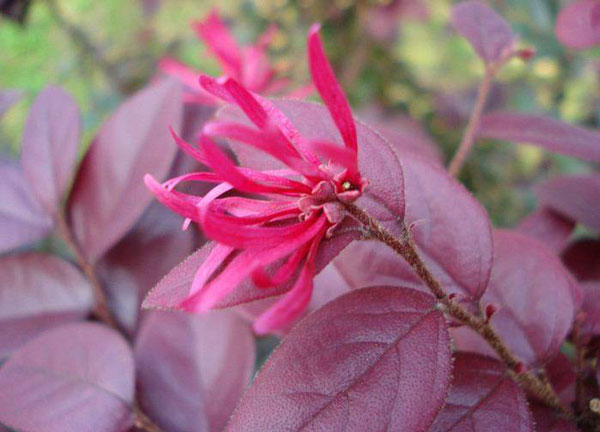
While many plants imported from Asia become invasive in North America, Chinese fringe flower is a safe choice for your landscape. The California Invasive Plant Council recommends picking this species over Russian olive, Brazilian peppertree and edible fig.
How to Choose and Prepare a Planting SiteWhen to Grow Chinese fringe flowers (Loropetalum chinense)How to Grow Chinese fringe flowers (Loropetalum chinense)How to Care for Chinese fringe flowers (Loropetalum chinense)Varieties of Chinese fringe flowers (Loropetalum chinense)Chinese fringe flowers (Loropetalum chinense) FAQ
How to Choose and Prepare a Planting Site
Woodland gardens, or areas beneath deciduous trees, are still the best plant to put your new Fringe Flower. They have a natural form that fits well, and they certainly brighten it up. If you are planting in shade, and want red leaves, then consider your variety carefully, as some are inclined to fade in summer. The form called Ever Red is highly regarded by experts, exactly because it doesn't fade in the shade, or with the passing of the seasons, but stays rich burgundy all the time.There is a tendency to just use plain evergreens around the house, often neatly trimmed. Consider adding plants like the Loropetalum to those areas – their foliage shows well against the rich greens, and their more casual growth contrasts perfectly with those rounded forms. That touch of color really lifts your foundation planting to a new level you will love – for no extra work.
Fringe Flowers are also perfect for larger planter boxes and tubs. Because they are so colorful you don't even need to plant anything else, and they live for years, with regular watering and fertilizer. In colder parts of zone 7 they may not be so suitable, as winter lows could cause root damage, but in other zones they will be just fine.
When to Grow Chinese fringe flowers (Loropetalum chinense)
Plant during milder months of spring or fall to avoid shock from extreme heat or cold.
How to Grow Chinese fringe flowers (Loropetalum chinense)
Steps for Chinese fringe flowers (Loropetalum chinense) Propagation with Seeds
If you want to grow your plant from seeds, you will have a little bit more work. Once the seeds are ripe, put them to a container about 0.5 inches (1.3 cm) below the surface of the ground. Water them well, and wait for your new plants to grow up.An ideal moment for planting seedlings is from October to the end of March, but it is essential to avoid frost periods. Wait for the soil to become drier, and dig a hole. It should be three times as wide as the root system of your Chinese fringe flower.
Put the 4 to 6 inches (10 – 15 cm) long seedling in the hole, and add the soil. After abundant watering, place a thick layer of organic mulch on the top.
Steps for Chinese fringe flowers (Loropetalum chinense) Propagation with Stem Cuttings
For guaranteed results, all you have to do is to use healthy softwood from the start. Look for newly growing stems and take cuttings of about 6 inches (15 cm) long. You must remove the leaves found on the bottom half of the stems to make sure that none are buried in the propagation medium. Moreover, dip the end of the cuttings into a rooting hormone for healthier and faster growth.Fill a container with a potting mixture made from equal parts of perlite and peat moss. The pot should have drainage holes at the bottom to prevent your cuttings from experiencing soggy conditions. Plant the cuttings in the substrate and cover the pot with a plastic wrap or bag, making sure the material does not touch the Chinese Fringe babies.
If you place the container in a warm location where they can receive plenty of indirect light and maintain the soil constantly damp, there is nothing else to do on your part. The cuttings should develop a strong root system in four to six weeks after planting. Once that period has ended, uncover the pot and care for the cuttings as for their mother plant. Let the little Chinese Fringe flowers in the current pot until the next planting season, then transplant them into the garden or their individual pots.

How to Care for Chinese fringe flowers (Loropetalum chinense)
Light
The Fringe Flower is colorful in full sun to partially shady locations inside or out. More shade develops foliage that tends to be less colorful with fewer flowers. Placing the Fringe Flower in bright diffused light will encourage brilliant blooms.Soil
Chinese fringe flower definitely likes growing in fertile, moist, and well-drained soil, but it can also put up with clay if it is necessary. Actually, every type of ground is tolerable for this plant except too muddy ones.Even though experts recommend growing this shrub in the acidic soil, most of them will do well in the alkaline ground as well. However, some varieties won’t thrive if the pH is higher than 5.1 to 5.5. As a result, you can experience the occurrence of yellow and malformed foliage, short branches, and a lack of blooms.
Water
Depending on rainfall, new plants need to be watered weekly through the first growing season. A slow, one-hour trickle of water should do the job. During hot spells thoroughly soaking the ground up to 8” (20 cm) every few days is better than watering a little bit daily. Deep watering encourages roots to grow further into the ground resulting in a sturdier plant with more drought tolerance.To check for soil moisture use your finger or a hand trowel to dig a small hole and examine the soil. If the first 2-4” (5-10cm) of soil is dry, it is time to water.
Monitor new plants through the first two years to make sure they are getting the moisture they need. After that they should be sturdy enough to survive on their own.

Temperature and Humidity
The fringe flower will tolerate winter temperatures as low as zero degrees Fahrenheit. However, in regions that have cold winters, it’s suggested that Chinese fringe flowers area unit planted in areas that shield them from cold winter winds. Though these evergreen shrubs area unit hardy to Zone seven, if they were fresh planted or in growth once this freeze hit, they’re additional vulnerable. At the smallest amount, they'll defoliate.Fertilizer
Established trees should be fertilized every 2-3 years. Feed in early spring when plants start growing.Fertilizers are available in many forms: granulated, slow-release, liquid feeds, organic or synthetic. Determine which application method is best for the situation and select a product designed for trees and shrubs, or go with a nutritionally balanced, general-purpose formula such as 10-10-10.
Always follow the fertilizer package directions for application rates and scheduling. Over-fertilizing plants or applying at the wrong time during the growing season can result in plant injury.
Pruning
Pruning may be needed to remove dead branches, encourage bushier growth, promote more flowers, or maintain a specific size or shape.Dead branches should be removed close to the trunk, flush with the bark. When pruning to control a plant's size or shape, cuts should be made just above a leaf bud and at a slight angle. This bud will be where the new growth sprouts.
Many shrubs can be regularly sheared to keep them shaped as a hedge, edging or formal foundation planting.
Always use sharp, clean tools when pruning. There are many tools available depending on the job. Hand shears, pruners, and loppers are ideal for most shrubs. Pole pruners and tree saws are better for large, mature shrubs or trees. If a tree is so large that it can't be safely pruned with a pole pruner, it is best to call in a professional tree service.
Pests and Diseases
When planted in optimal conditions and properly maintained, loropetalum exhibits few, if any problems. Possible diseases include mildew, anthracnose, root rot, or bacterial gall. There are no significant pest problems, but they can be susceptible to spider mites if kept too dry or in too much sun.
Varieties of Chinese fringe flowers (Loropetalum chinense)
Pink-Flowering Forms (Loropetalum Chinense Var. Rubrum)Pink-flowering forms (Loropetalum chinense var. rubrum)
They may have the red, purple, of maroon foliage with fantastic fuchsia, pink, or reddish-pink flowers. Their height and width vary widely depending on the type of this unique shrub.
White-Flowering Forms
Chinese Fringe Flower White-flowering forms
There are just three white varieties of Chinese fringe flower:
Carolina moonlight– It is 3 to 4 feet (0.9 – 1.2 m) tall, compact shrub with idyllic white flowers blooming from late winter to spring. However, you will enjoy its fabulous blooms from time to time throughout the season.
Snow muffin– This dense, roundish, 1 to 3 feet (30.5 – 90 cm) tall shrub is always full of the dark olive-green foliage and romantic blooms throughout winter and spring.
Emerald snow– With white flowers and green leaves, these 4 feet (1.2 m) tall shrubs are one of the most romantic plants I have ever seen.

Chinese fringe flowers (Loropetalum chinense) FAQ
Why My Loropetalum Aren't Blooming
Loropetalum usually bloom in spring and summer. If that isn't the case for your shrubs there are some simple ways to troubleshoot the problem. Typically the plants aren't blooming because of pruning during the winter, its the wrong time of the year or the plants aren't receiving enough sunlight.Is Chinese fringe flower invasive?
Invasive PotentialWhile many plants imported from Asia become invasive in North America, Chinese fringe flower is a safe choice for your landscape. The California Invasive Plant Council recommends picking this species over Russian olive, Brazilian peppertree and edible fig.
Is Chinese fringe flower poisonous to dogs?
All parts of loropetalum are non-toxic to dogs, cats, and children. Ingestion of any plants can cause mild stomach upset in some pets.
Latest Updated
- Benefits of Bugleweed - 7 Science-backed Health Benefits
- Bugleweed Dangers & Side Effects - Is It Poisonous?
- How to Plant Evergreen Trees - What You Should Know
- When to Plant Evergreens - Grow Guide for Evergreen Trees
- 12 Wonderful Evergreen Shrubs for Your Garden
- 12 Popular Evergreen Plants with Pictures for Beginners
- When And How To Prune A Lilac Bush Like a Pro
- How to Grow & Care for Lilac Vine (Hardenbergia Violacea)
- Japanese Lilac Tree (Syringa Reticulata) Care & Propagation Guide
- Shumard Oak Pros and Cons - What to Know
Popular Articles
- Winter maintenance of Antirrhinum Majus
- How to Grow Terminalia Mantaly Tree
- How to Grow and Care for Crossostephium Chinense
- How to grow Antirrhinum Majus in spring
- Peristeria Elata (Dove Orchid) Profile: Info & Care Guide
- Underwatered Snake Plant (Sansevieria Trifasciata) - Signs And How To Fix
- How to Care for Brazilian Jasmine Plant (Mandevilla Sanderi)
- How to Grow & Care for Graptopetalum Purple Delight in Summer
- Rosa Chinensis (China Rose): Plant Growing & Care Tips
- How to Care for Baby Sun Rose (Aptenia Cordifolia)